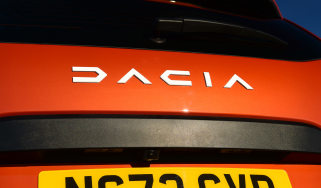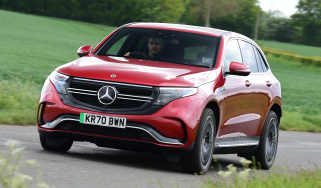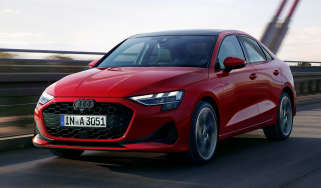Winter driving tips 2024
Top tips for winter driving, plus the do's and don'ts for handling snow and ice

Driving in winter can certainly be challenging and, just like your clothing, your driving style will need to be adapted in order to cope with ice-cold hazards such as ice, snow and fog. Our top winter driving tips will help you understand the precautions you should take to stay safe on the roads when the colder months roll in.
We also look at the steps you should take before your journey. There’s few things worse than being broken down at the roadside in sub-zero weather, so checking a few things such as your car’s antifreeze levels and tyre treads can make a real difference. As can carrying the correct cold weather equipment with you.
Winter driving tips
Read on to find everything you need to know about driving in winter.
Before your journey
Planning is everything so before heading out on the road in winter make sure you think ahead and weigh-up the risks.
Should you travel?
The first question to ask yourself is “do I need to travel?”. If the weather is bad and your journey isn’t essential then it’s always best to wait for the poor conditions to clear. If you must travel then it's important to pick the right roads and avoid areas that will be particularly weather beaten.
Plan ahead
Using a map app before travelling, and good sat-nav guidance while on route, will help you find out where the traffic is at its worst and avoid any accident sites. Also check the weather forecast to see if things are set to get any better or worse. Regardless of the current traffic and weather conditions, allow yourself plenty of extra time to get to your destination.
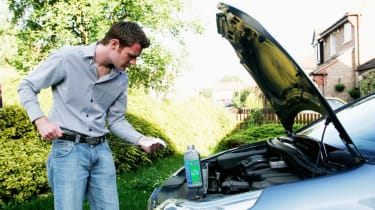
Prepare your car
Basic car checks should be carried out all year round but they’re particularly important in winter when a car’s components can be under more strain and the inconvenience caused by a breakdown can be that much greater.
Fluids
Make sure you have plenty of fuel – whether this is petrol, diesel or electricity – if you’re stuck in traffic or your car needs to work harder than usual in order to move, you will burn through fuel at a faster rate. It’s also a good idea to check your car’s other fluids, such as antifreeze and oil, in order to reduce the risk of a breakdown.
Visibility
Make sure your car is fully de-iced and that any snow is removed. Failing to sufficiently clear your car is against the law and you could incur a fine, as well as endangering yourself and other road users. Also make sure that your windscreen wipers are in good condition and your windscreen wash is fully topped-up.
Lights
Conduct a test of your car’s lighting before you set off, this is easy to do and will ensure that you are as visible as possible to other drivers. Keeping a spare set of bulbs within the car will also minimise the time and inconvenience of replacing a blown bulb.
Tyres
Inspect your tyres – including the spare – to make sure that they are fully inflated, in good condition and have plenty of tread. If the winter weather is particularly bad in your area, it may be worth investing in a set of winter tyres, snow socks or chains.
Faults
If you notice any faults with your car or it’s showing a warning light on the dashboard, it’s not advisable to set off without having this fault rectified. Taking a gamble could easily result in you being stranded at the roadside.
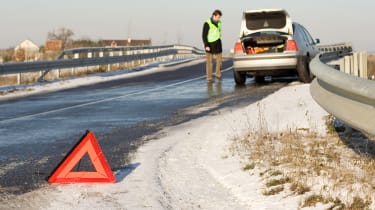
Go equipped
You need more kit in your car to travel safely and successfully in winter weather so make sure you assemble the key items before you set out.
Keep ice at bay
This may seem obvious, but keeping a can of de-icer and an ice scraper in the car will prevent you from being caught out by frosty windows.
Keep warm
Your car may have an effective heating system but make sure you pack suitable winter clothing such as a hat, scarf and coat in case you have to step outside.
Keep in touch
A fully charged mobile phone and battery pack will allow you to contact your recovery provider or the emergency services if needed.
Prepare for the worst
If you do end up stuck or broken down, a high-visibility jacket, shovel, tow rope, warning triangle, torch and jump leads could all quickly prove invaluable. A first-aid kit and some food and drink will also help to keep you comfortable and healthy.
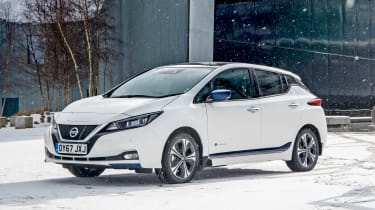
On the road
Here are our top tips for actually driving your car safely in bad winter weather…
Look ahead
Looking ahead is the easiest way to stay in control, but don’t just concentrate on the end of the bonnet or the car in front. Look as far ahead as you can see and then work back to the front of your car. When you approach a bend, look around it as far as you can. Doing this will allow you to prepare your speed and steering well in advance and avoid late and potentially dangerous movements.
Read the signs
Looking ahead doesn’t just mean looking at what other road users are doing and where the road goes. Road signs and markings can give you a heap of important information that can make you safer. Both standard and electronic road signs can assist you by displaying what the road surface is like, how steep the road is, what the speed limit is and what might be coming up. None of this should be ignored.
Stay visible
In conditions where visibility is reduced, such as fog or heavy rain, keep your dipped headlights on so that you can be seen by other road users. If you have automatic lights, override them so that they are constantly on. If visibility is 100 metres or less also use your fog lights. Remember that daytime running lights do nothing to illuminate the rear of the car so should not be relied on in low light conditions.
Use the right gear
In some cases, you might need to set off in second gear rather than first in order to prevent your wheels from slipping. If you drive an automatic car it may have the option to select second or another low gear manually. Some automatic models also feature a winter-driving mode which tells the gearbox to select a higher gear when setting off.
Keep your distance
In normal dry road conditions, the two-second rule to the car in front applies, but in wet weather you need to double this, while in icy conditions this should be up to 10 times greater. Extended separation distances are crucial in poor conditions where the road is slippery and tailgating is nothing short of reckless.
Control your speed
It’s not just grip on the road that can alter things as visibility is also greatly affected when driving in fog or heavy rain. You will see obstacles much later and this impacts on your ability to assess how to respond. Match your speed to visibility: the less you see, the slower you need to drive.
Drive smoothly
Applying too much power, braking abruptly or steering erratically can upset the balance of the car and ultimately lead to unsafe situations. Remember to brake, accelerate, change gear and apply steering angle as smoothly as possible. The smoother you drive, the less likely it is you’ll lose control. Steering inputs should be equally smooth – avoid jerky movements and try to plan ahead as much as possible.
Keep your feet on the pedals
Smooth driving doesn’t mean coasting, so you shouldn’t ever be not giving the car any input. If you’re not on the brakes, then you should be giving the car some throttle as this helps to manage weight transfer. It can be very tempting to brake and then coast around a corner, but it’s not advised. Just be sure to keep your inputs as smooth as possible.
Steer into the slide
If you drive over black ice and start to lose control, don’t panic and slam on the brakes. The best approach is to gently steer your car into the slide – rather than in the opposite direction – and keep steering until you feel the car straighten up. When doing this, do not take your hands off of the steering wheel or brake heavily.
Driving Downhill
Slow down as you approach the hill, leave plenty of room between you and the vehicle in front, stay in a low gear and maintain a low speed. This will help to prevent potentially disastrous skidding.
Driving Uphill
Leave plenty of room between you and other vehicles – or, if you can, wait until the hill is clear – maintain a steady but sensible speed, stay in a low gear and avoid braking or stopping unless necessary.
Be wary of the wind
High winds can suddenly impact a vehicle’s handling – particularly taller vehicles. If this happens, reduce your speed and keep both hands firmly on the wheel. Also be on the lookout for hazardous debris in the road.
Don’t be afraid to stop
If the conditions become too overwhelming, it’s far safer to stop in a safe place than it is to continue your journey. Look for a car park, service station or side road where you can park up safely and wait it out. Do not stop on the hard shoulder unless it’s an emergency.
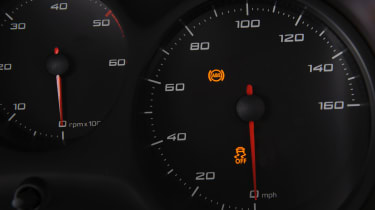
Understand your car’s safety systems
Modern cars, and even many older ones, have lots of safety systems designed to help the driver but it’s important for drivers to understand how they work and what happens when they intervene.
All of the technology below can be a great help when things get challenging on the roads, but driver aids can only do so much. If you don’t have tyres that are designed to handle winter weather, this will severely limit the amount of grip that your car has on the road and the ability of the electronic systems to intervene. Investing in a set of winter tyres could mean the difference between safety or potential disaster, so they are highly recommended if you’re planning to brave the snow and ice - especially on a frequent basis. Above all else, though, never use these systems as a substitute for careful driving.
Traction control (TCS)
Traction control is fitted to cars to prevent wheels from spinning up, and this can be the difference between going in a straight line or spinning in a circle on snowy roads. If your car’s Traction Control system detects that a wheel is spinning freely, it will temporarily reduce the engine’s power to help that wheel regain traction. When the system operates, a dashboard light will show and you may feel a rumbling sensation.
Anti-lock braking (ABS)
If you need to brake heavily, your anti-lock braking system (ABS) will probably activate. In simple terms, ABS uses sensors to detect when a wheel is about to lock up. When this is detected the system will rapidly apply and release the affected wheel’s brakes in order to prevent a skid. During this process you will feel a juddering sensation through the brake pedal, and a dashboard light may also appear. ABS is designed to shorten your emergency stopping distance, but it also provides valuable steering control under braking.
Electronic Stability Control (ESC)/Electronic Stability Program (ESP)
Electronic Stability Control systems go by several different names, depending on your car’s manufacturer, but their basic function remains the same. ESC/ESP measures the speed of each individual wheel, the steering input and the angle and direction of the car. If a wheel starts to lose traction, this system works in conjunction with the TCS and ABS systems to apply precise amounts of braking to each wheel and cut the engine power where necessary.
Hill descent control (HDC)
Hill descent control systems are primarily intended for off-road use, but they can also prove effective when tarmac is buried under snow and ice. If you are about to descend a steep gradient and your car has a hill descent control system, you will first need to stop the car in a safe place and then manually engage the HDC via a button or the touchscreen. Once engaged, the car will be limited to a low speed in order to allow the system to function. Sensors will constantly monitor the wheels, and automatically apply the throttle and brakes accordingly to maintain this low speed. You will still need to steer carefully, though.
Four-wheel drive (4x4)
Four-wheel drive is perhaps the most well-known system for handling challenging terrain. Although it’s traditionally associated with big off-roaders, four-wheel drive is fitted to a range of cars including sports cars and supermini-based small SUVs. There are a number of different versions of 4x4 systems, along with a variety of names, but the basic principle is the same: when four-wheel drive is in operation all four wheels are driven by the engine and gearbox, resulting in greatly increased traction.
Get fully prepared for winter by reading more via the links below...

